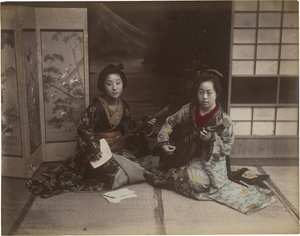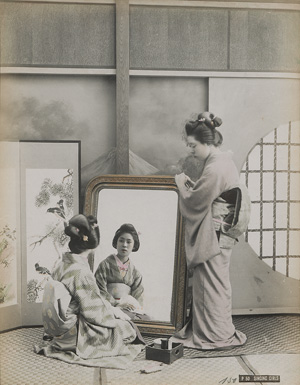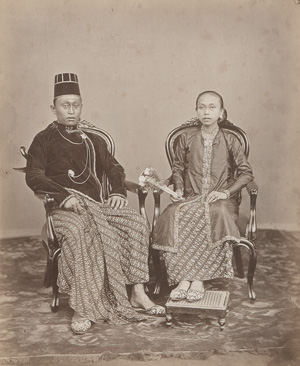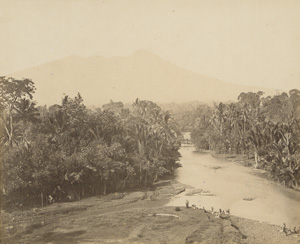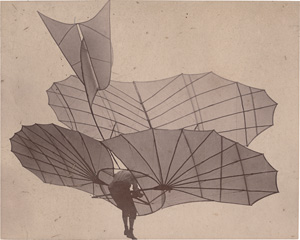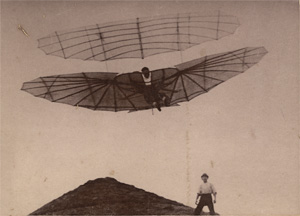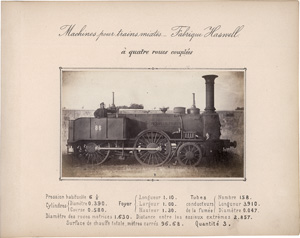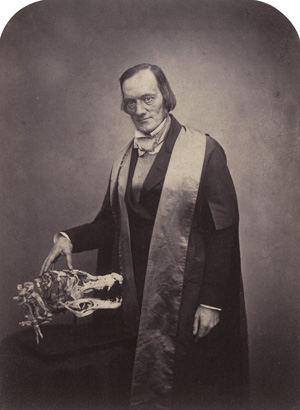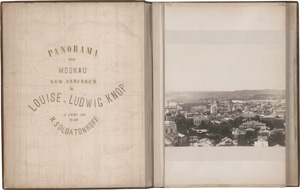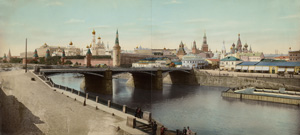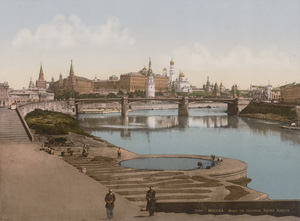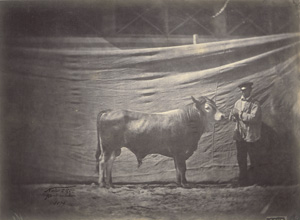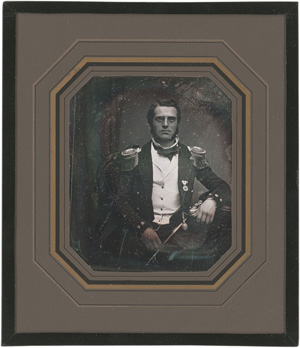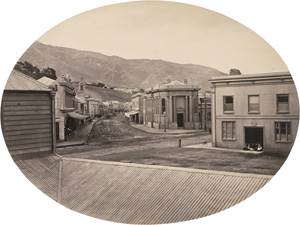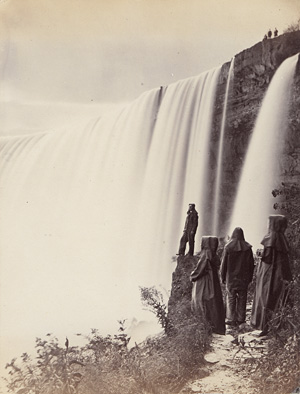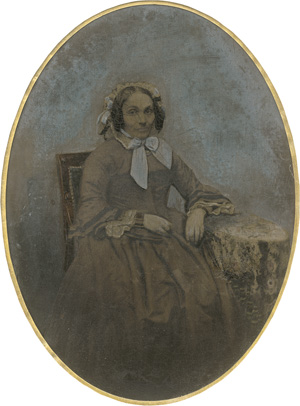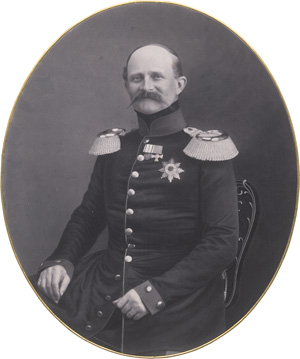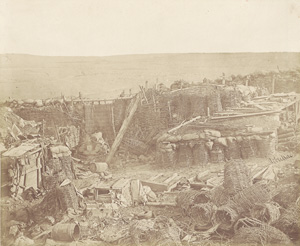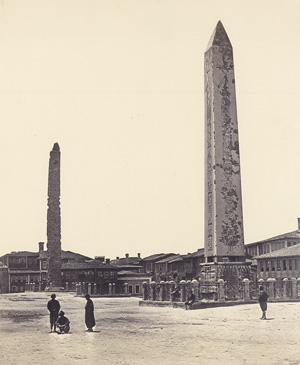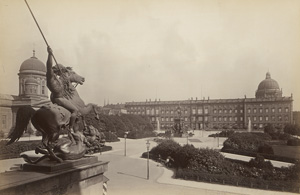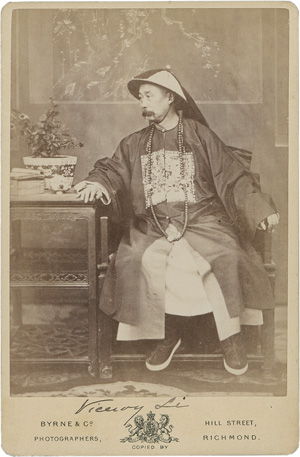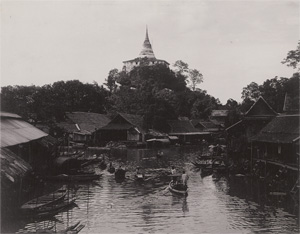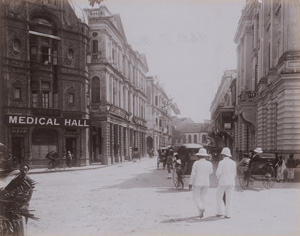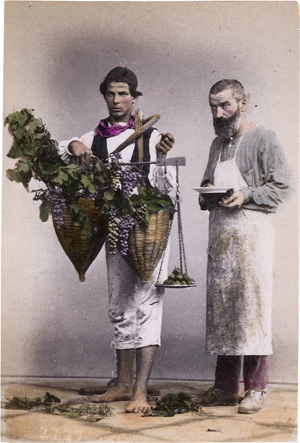Photographer: Kusakabe Kimbei (1841-1932), attributed to. Selected genre scenes. 1880s. 3 hand-colored albumen prints. Each circa 20 x 26 cm and 26 x 20 cm.
In 1885, Kusakabe Kimbei - formerly an assistant and colorist for Felice Beato - acquired Beato’s Yokohama studio from Baron Raimund von Stillfried-Rathenicz, who had purchased it in 1877. From 1885-1910, Kimbei emerged as one of Japan’s leading commercial photographers, playing a pivotal role in shaping the visual identity of Meiji-era Japan and contributing significantly to the early history of photography in the country. – Some light handling marks, some pressure marks from album page slits in corners, minimal fading in edges, otherwise in very good condition.
Photographers: Adolfo Farsari (1841-1898) and others. Landscapes and portraits. 1890s. 22 hand-colored albumen prints. Each circa 21 x 27 cm. Some with title and number in the negative in lower margin.
This well-preserved group of hand-colored albumen prints offers a vibrant depiction of Meiji-period Japan, combining landscape views with a variety of portrait subjects. Among the highlights are outdoor scenes featuring geisha in traditional dress, captured in garden settings or temple courtyards, as well as more formal studio compositions. Particularly notable is a rare image of kabuki actors performing a stylized reenactment of seppuku (ritual suicide), reflecting the era’s theatrical and cultural traditions. Produced for the export market, these prints exemplify the refined coloring and compositional elegance characteristic of Yokohama studios such as that of Adolfo Farsari. – Several with minimal fading in edges, otherwise in good to very good condition with fine hand-coloring.
Photographer: Woodbury & Page (active 1857-1908). Views and portraits from Java, including Batavia, Bekasi, Pati, and Surakarta. 1870s. 10 albumen prints, mounted to board. Each ca. 19 x 24 cm (25 x 30 cm) or reverse. Some with printed studio name in the negative.
This group documents key moments and figures from colonial-era Java during the late 19th century. Among the images are the execution of the so-called Tambun murderers in Bekasi (1869), the Bupati of Pati, Raden Adipati Arya Candra Adinegara with his entourage, and the royal procession of Pakubuwono IX, Susuhunan of Surakarta. Also included are striking portraits of wayang topeng performers, views of village life, and ceremonial gatherings. These prints exemplify Woodbury & Page’s distinctive ability to combine ethnographic detail with a formal photographic sensibility, capturing the diverse visual culture of the Dutch East Indies with remarkable clarity. – Some foxing of mounts, some fading and light scuff marks, otherwise all in good to very good condition.
Photographer: Woodbury & Page (active 1857-1908). Views of Java. 1870s. 30 albumen prints, mounted to boards. Each ca. 19 x 24 cm or reverse (34,5 x 46 cm). With the photographer’s blind stamp embossed in lower right corner and handwritten captions in pencil below the images on the mount. Presented in canvas-backed clamshell box with silk-lined interior and richly hand-illustrated title leaf featuring Javanese script and a dedication to “Fürst Bismarck.”
This rare and visually striking set offers a wide-ranging photographic survey of colonial Java in the 1870s, including Batavia (Jakarta), Buitenzorg (Bogor), Bandung, Garut, and surrounding volcanic landscapes. The images depict prominent civic buildings such as the former Stadhuis of Batavia, the military hospital, colonial residences, botanical gardens, bridges, markets, and staged ethnographic scenes. Figures in traditional dress appear throughout, offering glimpses of daily life in the Dutch East Indies. The group includes a richly hand-illustrated title page with gold embellishments and Wayang-style figures, bearing a dedication to “Fürst Bismarck” in Javanese script and Latin lettering-suggesting the set was conceived as a diplomatic or commemorative gift to the German Chancellor during a period of expanding international influence.
– Some foxing, smudge marks, and small tears on a number of boards. Some prints show fading, foxing, and/or spotting, as well as traces of silver mirroring along the edges. Otherwise, all in good to very good condition.
Lilienthal, Otto
Otto Lilienthal flying his gliding plane "Großer Doppeldecker"
Los 4065
Schätzung
2.000€ (US$ 2,222)
Photographer: Dr. Richard Gustav Neuhauss (1855-1915). Otto Lilienthal flying his gliding plane “Großer Doppeldecker”, Fliegeberg, Berlin-Lichterfelde. Oct. 19, 1895. Vintage gelatin silver print, mounted to board. 16.4 x 20.6 cm. Captioned “Stöllen 1895” in white ink below the image on the mount.
The evolution of photography and aviation shares interesting similarities. In 1884, Ottomar Anschütz began capturing images of storks in flight, marking the first momentary snapshots in the history of photography. By 1890, he developed the "Tachyscope," displaying sequential images of people and animals in motion, which gained popularity at the 1893 Chicago World's Fair, highlighting advancements in transportation and industry through widely distributed photographs. In 1891, Otto Lilienthal initiated his flight experiments, lasting five years until his unfortunate death in 1896, due to a flight accident. During this period, photographers such as Ottomar Anschütz, Carl Kassner, Richard Neuhauss, and Alex Krajewski documented Lilienthal's flights near Berlin. These images often circulated as photo postcards and served as crucial documentation for Lilienthal. Unfortunately, the glass negatives of Lilienthal's photographs, archived in the Deutsches Museum in Munich, were destroyed during WWII. – Slight signs of wear to the boards; some spots and specks, otherwise in good condition.
Lilienthal, Otto
Otto Lilienthal flying his gliding planes
Los 4066
Schätzung
1.500€ (US$ 1,667)
Photographers: Dr. Richard Gustav Neuhauss (1855-1915), A. Regis and others. Otto Lilienthal flying his gliding planes at Rhinower Berge (Maihöhe-Rhinow) and Fliegeberg, Berlin-Lichterfelde. 1893-96. 8 vintage gelatin silver prints, mounted to boards. Various sizes between 16,4 x 22 cm and 10 x 13 cm. Some captioned in white ink below the image on the mount.
Boards with some traces of use, prints with some spots/flecks, some with scratches to emulsion surface and one with small hole.
Lombard-Venetian Railway
Inventaire photographique et statistique du matérial roulant sur le réseau Vénetien et du Tirol Meridionale
Los 4067
Schätzung
900€ (US$ 1,000)
Photographer unknown. Inventaire photographique et statistique du matérial roulant sur le réseau Vénetien et du Tirol Meridionale. 1863. 29 albumen prints, mounted to album boards. Most circa 8,5 x 14 cm. Each with printed captions above/below images on the mount, bound in half-canvas album with gilt-lettered title page.
Rare documentary album illustrating the rolling stock of the Venice-South Tyrol railway network in 1863, compiled shortly before the region transitioned from Austrian to Italian control. The photographs present a comprehensive visual survey of mid-19th-century rail technology, featuring locomotives, passenger coaches, and freight wagons manufactured by leading European firms including Köchlin, Stephenson, Schneider, Cail, Haswell, and others. Each image is accompanied by printed captions detailing technical specifications, making the album a valuable industrial inventory. Produced during a moment of intense political and technological change, it offers a significant historical record of early railway infrastructure in Northern Italy and the former Austrian Empire. – Album pages slightly warped, prints with some fading in edges, otherwise in very good condition and many with strong contrasts.
Maull & Polyblank
Portraits of British public figures
Los 4068
Schätzung
1.200€ (US$ 1,333)
Portraits of British public figures. Circa 1857-1864. 4 Woodburytypes, mounted to card with printed gilt border. Each 20 x 14,8 cm (26,5 x 21,6 cm). Titled in pencil or ink by hand on the mount below the image; photographer’s credit printed on the mount: “Photographed by Maull & Polyblank, 55, Gracechurch Street and 187a, Piccadilly, London.”
This group of early photographic portraits by the London studio Maull & Polyblank features prominent figures of mid-Victorian public life. Among them are Sir Richard Owen, the pioneering comparative anatomist and founder of the Natural History Museum in London, shown with a fossil specimen; Sir William Sterndale Bennett, influential composer and Principal of the Royal Academy of Music; Lord Stanley, later the 15th Earl of Derby and a three-time British Foreign Secretary; and Charles Kean, celebrated Shakespearean actor and theater manager. Taken between 1857-1864, these portraits exemplify the studio’s ambition to create a visual pantheon of British cultural and political leadership. – Some minor scuff-marks and surface irregularities, otherwise very strong tonal prints in near excellent condition.
Men of Mark
Heinrich Schliemann, Charles Darwin and Jules Verne
Los 4069
Schätzung
400€ (US$ 444)
Photographers: Samuel Lock (1822-1881) and George Whitfield (ca. 1832-1904). Heinrich Schliemann, Charles Darwin and Jules Verne, from the series “Men of Mark”. 1877. 3 Woodburytypes. Each circa 11,5 x 9 cm (27,2 x 20,5 cm). Each mounted to book page and titled and annotated on the mount, 2 with text page.
These three portraits of Heinrich Schliemann, Charles Darwin, and Jules Verne are from the renowned series “Men of Mark” by Lock & Whitfield, issued between 1876-1883. The project featured prominent figures in science, literature, and public life, reproduced in high-quality Woodburytypes and accompanied by short biographical texts. The sitters of these bust-length portraits reflect Victorian ideals of intellectual and cultural achievement, and are portrayed with composure and gravitas. The inclusion of Darwin, Schliemann, and Verne highlights the period’s fascination with discovery, both scientific and imaginative. – Minimal buckling, Darwin print with irregular surface, otherwise in excellent condition.
Photographers: Scherer & Nabholz (active ca. 1860-1868), published by Kozma Terentyevich Soldatyonkov (1818-1901). Panorama von Moskau. 1867. 16 albumen prints, mounted to boards and joined with paper tape into an accordion-fold panorama. Each ca. 34 x 40 cm (entire size: ca. 640 x 61 cm). Additional mounted albumen print (ca. 27 x 33 cm) on the inside of the rear board, depicting the Cathedral of Christ the Savior. Bound in full-leather album with raised decorative border and large embossed presentation in Russian within raised oval frame on upper cover; front pastedown with gilt-stamped presentation inscription in German: “Panorama von Moskau. Zum Andenken für Louise u. Ludwig Knop. 10 Juni 1868 von K. Soldatonkoff.”
This panorama of Moscow, composed of sixteen large-format albumen prints joined to form a 360-degree view of the city, is among the most technically ambitious photographic achievements of 19th-century Russia. Taken in 1867 from the rooftop of the then-unfinished Cathedral of Christ the Savior, the photographs depict the city in panoramic detail - from the bend of the Moskva River to the walls of the Kremlin - providing a broad view of Moscow’s religious, political, and industrial center. Extending over six meters when fully assembled, the panorama’s scale and the precision of its alignment represent a notable technical achievement of the period.
The work is attributed to the Swiss-born photographers Martin Scherer and Georgy Nabholz, whose Moscow studio was known for its large-format city views. Using the wet-collodion process, they produced sixteen carefully composed exposures from a high vantage point, coordinating them so precisely that the transitions appear uninterrupted. Their studio had received a silver medal for photographic excellence at the Moscow industrial exhibition of 1865, and this panorama, conceived at the height of their collaboration, is regarded as one of their principal works.
The project was commissioned and published by Kozma Terentyevich Soldatyonkov (1818-1901), a textile magnate, philanthropist, and prominent figure in Moscow’s cultural life. Rather than intended for commercial distribution, it was presented as a gift to select individuals. This copy was inscribed and presented in June 1868 to Ludwig Knoop (1821-1894) and his wife Louise. A Bremen-born industrialist, Knoop had settled in Russia in the 1840s, contributed decisively to the development of the textile industry, and was later ennobled by Tsar Alexander II.
Only one other example of this panorama is known, preserved in the Joachim Bonnemaison Collection of Panoramic Photography at the Getty Research Institute in Los Angeles, formerly part of the library of the Dukes of Saxe-Coburg-Gotha. No copies are recorded in Russian institutions. Its rarity, provenance, and scale - combined with its technical sophistication and ceremonial character - underscore the album’s significance as a landmark of 19th-century Russian photographic, urban, and diplomatic history. – Accordion folds reinforced with later paper tape, some sections lifting or torn; some foxing, smudge marks, and very light edge fading on several prints; deep scratches in the lower portion of two boards. Otherwise, all prints with strong tones and in good to very good condition.
Provenance: Gifted by Kozma Terentyevich Soldatyonkov to Louise and Ludwig Knoop in 1868; thereafter by descent in the Knoop family; Villa Grisebach, Berlin, 26 November 2014, lot 2167; Sotheby’s, London, 28 April 2016, lot 53.
Photographer: Joseph Daziaro (1831-1892), attributed to. Large panoramic view of Moscow. 1880s. Hand-colored, two-part panoramic albumen print. 40,5 x 89 cm. Flush-mounted to board.
This two-part panorama provides a wide view across central Moscow, likely photographed from an elevated vantage point. Landmarks such as the Kremlin walls, the Cathedral of Christ the Savior, and various church domes are visible in the distance. The hand-coloring emphasizes architectural detail and topographical depth. Daziaro, active as a publisher and photographer in Moscow and St. Petersburg, is known for producing high-quality city views for the local and tourist market. – Finely hand colored panoramic view consisting of two large format prints in very good condition.
Photographer unknown. Views of Moscow. 1880s. 24 photochromes mounted to red-edged board. Each circa 20 x 25 cm and 25 x 20 cm. Each with gilt-stamped number/title in lower edge in French and Russian; bound in textured leather album with gilt-embossed title "Souvenir de Moscou" on front cover.
A few prints with light surface rubbing, otherwise in very good condition with bright colors.
Taureau Landais. 1856. Varnished salted paper print, mounted to board. 19,6 x 27 cm (29,7 x 37 cm). Photographer’s signature stamp and number in the negative in lower right, titled “Taureau Landais” in black ink below the image on the mount, numbered “33” in pencil.
Adrien Tournachon, younger brother of the famed Nadar, briefly collaborated with him before a legal dispute in 1855 barred Adrien from using the name “Nadar jeune.” He later focused on documentary photography, notably producing over 120 collodion wet plate negatives of prize-winning livestock at the 1856 Paris agricultural fair, with around 50 included in a presentation album for the Minister of Agriculture. The present print was made using the vernis-cuit technique, which imparts a rich, varnished-leather appearance to the paper. – A few light pressure marks, slightly faded in some areas, otherwise a rich dark print in very good condition.
Photographer: Carl Wigand (1845-1883). Portrait of Adolph Wilhelm Berger (1829-1898). 1850s. Quarter-plate daguerreotype with gilt-ruled paper surround. Ca. 9 x 7,5 cm. Newly sealed behind glass in modern brown canvas clamshell box with gilt-stamped title "Adolph Berger".
This finely preserved daguerreotype portrays Adolph Wilhelm Berger in the uniform of a Prussian naval officer, bearing the rank of Leutnant zur See II. Klasse. Likely taken to commemorate his promotion in 1855, the portrait was commissioned at the studio of Carl Wigand in Berlin, then one of the city’s leading daguerreotypists. Berger began his naval training in 1848, when he and four fellow cadets joined the U.S. frigate St. Lawrence in Bremerhaven to study American naval practices - part of a broader advisory initiative led by Captain Hiram Paulding to support the development of German naval forces. The mission ended in July 1849 with the cadets’ discharge following the ship’s return to Bremerhaven, as Prussia had entered into conflict with Denmark.
Further instruction followed in 1863-64, when Berger trained aboard H.M.S. Black Prince with the British Royal Navy. He sustained serious injuries during the Second Schleswig War in 1864 while serving on the Arcona. Between 1867-1877, he commanded several vessels, including the Musquito, Niobe, Hansa, Renown, and the armored frigate Friedrich Carl. He ultimately rose to the rank of Vice Admiral, marking a distinguished career in the formative years of the Prussian and later Imperial German Navy. – Tarnishing in edges, otherwise in very good condition.
Lit.: Hans H. Hildebrand and Ernst Henriot. Deutschlands Admirale 1849-1945. Osnabrück: Biblio Verlag, 1988.
New Zealand
Views of cities and landscapes of New Zealand
Los 4075
Schätzung
600€ (US$ 667)
Photographer unknown. Views of cities and landscapes of New Zealand. 1860s. 16 albumen prints, several oval, mounted to board. Each circa 19 x 16 cm. Some annotated in pencil in German below the images on the mount as well as on mount verso.
These early views of New Zealand include cityscapes of Auckland and the harbor of Wellington, alpine and glacial landscapes, as well as a rare early panorama of Nelson. Among the more unusual subjects is a photograph depicting the consulate building of the “Freie und Hansestadt Hamburg” on Queen Street in Auckland.
– Time-stained and soiled mounts with some foxing. Some photos faded, a few with scuff marks, some with spots, otherwise most in good to very good condition and several with strong violet brown tones.
Photographers: Josiah Martin (1843-1916), and others. Maori portraits. Mid-1870s. 12 albumen prints, mounted to board. Each circa 9 x 6 cm, a few larger. A few with title and number in the negative, some annotated in ink below the image on the mount.
This group comprises both individual and composite portraits of prominent Maori figures, including Chief Tawhiao, Kawiti, Mohi, Rewi, and Ringorī. Several appear in a photographic montage combining eleven portraits with ethnographic views: a carved meeting house, the settlement at Parihaka, a Rotorua village scene, a war canoe, and six carved figurative sculptures. A print of this montage is held in the British Museum collection. Also included are a larger photograph of a traditional Maori dwelling and several smaller-format studio portraits, offering a rare visual record of Maori leadership and culture in the late 19th century. – Mounts slightly time-stained in edges. Prints in good condition.
Photographer unknown. Views of Niagara Falls. 1860s. 4 albumen prints, mounted to board. Each circa 19 x 14,5 cm (30,4 x 40,2 cm) or reverse. Some with handwritten captions in the lower margin or on the mount.
In the nineteenth century, Niagara Falls emerged as a major subject for photography, with pioneers such as George Barker, Samuel J. Mason, and Platt D. Babbitt capturing its dramatic beauty using large-format cameras. Their photographs served both scientific and artistic aims - documenting natural phenomena while also fueling the growing tourism industry. These powerful images helped form Niagara Falls’ status as one of the most iconic and visited natural landmarks of the era. – Some buckling of mounts, some light scuff marks, otherwise in good condition.
Photographer: Jean Nicolas Truchelut (1811-1890). Portrait of a woman. 1857. Pannotype. 22 x 16 cm (31 x 25 cm). Light hand-coloring and highlighting, mounted in contemporary gilt-lined paper mat, photographer's printed paper label and annotated with the sitter's name and dates in ink on mat verso.
The pannotype (from pannus, Latin for linen) is a positive collodion image transferred onto fine fabric, typically linen. Introduced around 1853 by Jean Nicolas Truchelut, the process offered a more affordable and durable alternative to daguerreotypes and early paper prints, though it lacked their luminous quality. Due to its technical complexity and labor-intensive production, the pannotype remained a niche format, adopted by only a handful of photographers. Today, surviving examples are exceedingly rare - especially in larger formats such as this.
– Mat with traces of use, some soiling, print with some cracklure, background mottled, otherwise in good condition.
Photographer: Lutz & Witte (attributed to). Portrait of Prinz August von Württemberg. 1860s. Salted paper print, mounted to card with ornamental frame and gilded border. Ca. 14 x 19 cm. Signed by the sitter in ink on the mount: “Prinz August von Württemberg.”
This portrait depicts Prince August of Württemberg, a high-ranking military officer and uncle to King Karl I of Württemberg. Born into one of Germany’s most prominent royal families, August held influential positions within the Prussian army and played a notable role in 19th-century European military and court life. His composed, uniformed appearance reflects the formality and stature expected of a nobleman of his rank. – Some foxing to the mount, ornamental frame partly torn off. The image itself is well preserved and in good overall condition.
Robertson, James
Interior of the Malakoff Tower, Crimea
Los 4080
Schätzung
1.000€ (US$ 1,111)
Interior of the Malakoff Tower, Crimea. 1855. Salted paper print, mounted to board. 24,2 x 29,6 cm (38 x 45,8 cm). With ruled border and handwritten caption in black ink below the image on the mount; signed “Robertson” in brown ink in the right margin of the print.
Taken by James Robertson during the Crimean War in 1855, this photograph shows the interior of the Malakhov Tower shortly after its capture by Allied forces. The image records the chaotic aftermath of battle - with shattered gabions, sandbags, timber, and entrenchments - offering a stark visual impression of the scale and violence of the conflict. A striking example of early war photography, it not only documents a pivotal episode in the Siege of Sevastopol but also reflects the emerging power of the photographic medium to bear witness to modern warfare. – Some handling creases as well as a small tear on lower margin of mount; print slightly faded, otherwise in near excellent condition.
View of Sebastopol harbor from the Redan. 1855. Three-part salted paper print panorama, mounted to card. Each ca. 23 x 30 cm (entire size 38 x 102 cm). Signed “Robertson” in brown ink in the lower left corner of far-left print.
This three-part salted paper print panorama offers a sweeping view across the devastated cityscape of Sebastopol in the aftermath of the 1855 siege. Taken from the vantage point of the Redan, the photograph captures the strategic harbor, rubble-strewn terrain, and key landmarks identified in ink on the mount, including St. Vladimir’s Church, Lancashire Trench, Barracks to Seamen’s House, and the Dockyard with steamers beyond. The panoramic format heightens the immersive impact of the scene, conveying both the geographical scale of the conflict and the physical toll of prolonged bombardment. As one of the earliest battlefield panoramas in the history of photography, it represents a major milestone in the visual documentation of modern war. – Some handling creases, small tears and foxing on the mounts, light buckling and fading to the prints, otherwise well-preserved with fairly strong contrast and rich detail.
Robertson, James & Felice Beato
Views of Constantinople
Los 4082
Schätzung
6.000€ (US$ 6,667)
Views of Constantinople. Early 1850s. 12 albumen prints, mounted to board. Most 30,5 x 26 cm or reverse and four 10 x 18 cm. Several signed and titled in the negative in lower edge; with title page with gold lettering, in modern presentation folder.
During the 1850s and 1860s, James Robertson and Felice Beato operated a prominent photography studio in Pera, the European quarter of Constantinople. Their partnership began around 1853, resulting in the formation of Robertson & Beato - one of the earliest commercial photography studios in the region. They were later joined by Beato’s brother, Antonio, further expanding the scope of their activities. Together, they produced an extensive body of work that documented the city’s architectural landmarks, varied landscapes, and scenes of everyday life, offering a vital visual record of the Ottoman Empire in the mid-19th century. Concluding the album are four private photographs depicting British naval officers and a steamer. – Boards minimally toned in edges, some prints with light foxing, a few slightly faded in lower edge, otherwise most are strong prints in very good condition.
Rückwardt, Hermann
Berlin und seine Umgebung in Architektur, Landschaft und Plastik
Los 4083
Schätzung
2.000€ (US$ 2,222)
Berlin und seine Umgebung in Architektur, Landschaft und Plastik (Format IV). 1879-1882. 69 albumen prints, mounted to boards. Each ca. 21,5 x 32 cm or reverse (36 x 49 cm). Each with photographer’s studio information, title, date, and architect’s name printed in letterpress below the image on the mount. Presented in original wooden box with leather covering, gilt tooling, and gilt-embossed title on the lid.
A comprehensive visual survey of Berlin in the late 19th century, this rare compilation presents a wide array of architectural and urban views, many of which depict structures no longer extant. Among the highlights are detailed exterior and interior photographs of the Stadtschloß, the Lustgarten with the old Domkirche, and several now-lost official buildings along Unter den Linden. The album further includes rare views of the historic bridges and canals around Fischerinsel, the monumental ensemble of the Museumsinsel, the Neue Synagoge on Oranienburger Straße, and the Kaiser-Passage with its famed Panoptikum. Also featured are tranquil scenes from the Tiergarten, the Flora in Charlottenburg, and several newly built railway stations, reflecting the city’s rapid modernization. Together, the images offer a richly detailed record of Berlin’s architectural heritage at a moment of imperial grandeur and transformation. – Several boards with small tears; a few prints with minimal edge fading, light surface abrasion, or small retouched spots. Otherwise, the prints are strong, with fine detail, and overall in good to very good condition.
Lit.: Märkisches Museum Berlin, ed. Berlin zwischen Residenz und Metropole: Photographien von Hermann Rückwardt 1871 - 1916. Berlin 1994.
Early views of Nuremberg. 1860s. 6 albumen prints, mounted to boards. Circa 25 x 27 cm and reverse (31 x 40). With handwritten caption in black ink below the image on mount.
This group of early views by Nuremberg-based photographer Georg Schmidt includes prominent architectural landmarks such as the Lorenzkirche, Hauptmarkt with the Schöner Brunnen, the Sebalduskirche, the Rathaus, and views toward the imperial castle. Taken from both street level and elevated vantage points, the images reflect Schmidt’s painterly eye and technical command of the albumen process during the early years of German photography. – Some fading, scuff marks, and rubbing on surface of prints, otherwise all in good to very condition.
(Attributed to). Panorama of Cairo. 1870s. Panorama consisting of 6 albumen prints, mounted to boards. Each ca. 25 x 30,5 cm (entire size 25 x 182 cm). In red canvas presentation folder with gilt embossed title "Kairo" on front cover.
This six-part panorama of Cairo, attributed to Pascal Sébah, depicts a sweeping view of the city’s historical and architectural landmarks, including such sites as the Muhammad Ali Mosque, the Cairo Citadel, the aqueduct, the northern cemetery, and the mosques of Sultan Hassan and al-Rifa’i among others. – Boards slightly toned, folder slightly soiled and with some spots, some fading at folds of prints, otherwise in very good condition.
Sébah, Pascal and Policarpe Joaillier
Panorama de Constantinople - Tour de Galata
Los 4086
Schätzung
1.200€ (US$ 1,333)
Panorama de Constantinople pris de la Tour de Galata. Circa 1880. Panorama consisting of 10 albumen prints. Each circa 25 x 33,5 cm (entire size circa 25 x 340 cm). Mounted to original boards, bound together with linen tape at folds, in original red canvas portfolio with gilt-stamped title and ornament.
An unusually large panorama taken from the Galata Tower, offering a sweeping view across the Bosporus from the Asian shore of Üsküdar to the Topkapi Palace, extending over the Golden Horn and into the western quarters of the city. – Boards slightly toned with light foxing spots; portfolio slightly soiled and worn, spine professionally repaired. Some foxing, especially in sky areas; some areas slightly faded; red stain to upper corner of second board; otherwise in very good condition with strong contrasts.
Lit.: Bodo von Dewitz, ed. An den süssen Ufern Asiens (exhibition catalogue). Cologne: Museum Ludwig, 1988, ill. p. 164, (variant in foldout supplement).
Portrait of Li Hongzhang (1823-1901) in Tientsin. 1879. Cabinet albumen print. 14,2 x 10 cm. Mounted to studio board of Byrne & Co., Richmond, annotated "Viceroy Li" in ink below the image on the mount.
An intriguing artifact of early photographic circulation, this cabinet photograph is credited to Byrne & Co. of Richmond, England. However, the image is in fact a well-known portrait by Liang Shitai (also known as See Tay), a pioneering Chinese photographer active in Hong Kong during the 1870s. Liang established one of the most prominent studios in the colony before relocating to Shanghai in 1876 and later to Tientsin (Tianjin) in 1880. He became renowned for his portraits of high-ranking Qing officials and members of the imperial court.
The sitter, Li Hongzhang, was one of the most influential statesmen of the late Qing dynasty - a general, diplomat, and reformer who played a central role in suppressing major uprisings and negotiating foreign treaties. He held numerous senior posts, including Viceroy of Zhili, Huguang, and Liangguang. The reattribution of Liang’s portrait to an English studio speaks not only to the sitter’s international prominence but also to the commercial demand for his likeness in the West. A hand-colored version of this portrait is held in the collection of the New York Public Library. – A few light pressure marks, minimal fading in edges, otherwise in very good condition.
Lit.: Terry Bennett. History of Photography in China: Chinese Photographers 1844-1879. London: Quaritch, 2013, ill. p. 261 (with different hand-coloring).
Jeffrey W. Cody and Frances Terpak, eds. Brush and Shutter: Early Photography in China. Los Angeles: Getty Research Institute, 2011, ill. p. 126, plate 6.
Photographer: Philip Klier (active ca. 1880-1911). Views of Bangkok, Paknam, Rangoon, and Mandalay. 1906. 22 gelatin silver and collodion prints, mounted to boards. Each ca. 22,5 x 28,5 cm (28,5 x 40 cm). Most with handwritten caption in black ink below the image on the mount, some with the photographer’s studio information in the negative.
This group of photographs records significant religious, architectural, and urban sites in Siam and British Burma during a documented journey in late 1906. Among the Bangkok scenes are canal-side dwellings near the Golden Mount (Wat Saket), temple complexes such as Wat Pho and Wat Suthat, and detailed views of the Grand Palace and Wat Phra Kaeo. Further images show the island temple of Phra Samut Chedi at Paknam, the Shwe Dagon Pagoda in Rangoon from multiple vantage points including the Royal Lake and Cantonment Gardens, and distinctive scenes of Mandalay, including palace walls and a large monastic structure. – Some light scuff marks and minor oxidation along the edges of some prints, otherwise all in very good condition.
Photographers: G. R. Lambert & Co. (active ca. 1880-1910) and unknown. Views of Singapore. 1880s-1890s. 20 collodion and albumen prints, mounted on boards. Each ca. 21,5 x 27 cm (27 x 34 cm) or reverse. Most with the photographer’s studio stamp embossed in the lower left corner, some with handwritten titles below the image on the mount.
This extensive group of photographs offers a richly detailed visual record of Singapore at the height of the colonial period. Produced primarily by G. R. Lambert & Co. - the leading commercial photography studio in British Malaya - the images document both iconic landmarks and everyday street scenes. Highlights include the bustling activity of Boat Quay and Keppel Harbor, lively street views with rickshaws and pedestrians in tropical attire, as well as notable colonial-era buildings such as the Police Court and Medical Hall. Also featured is the Hindu temple at South Bridge Road, along with verdant botanical studies, including the striking symmetry of a traveller’s tree (Ravenala madagascariensis) and a distant view of Tyersall Palace nestled within the Singapore Botanic Gardens. One photograph, likely by another photographer, presents a scenic view across the straits toward a Malay village, possibly Kampong Telok Saga on Pulau Brani. – Some light fading, occasional surface spotting and scuff marks, some with light creases and small edge tears, otherwise in good to very good condition.
Neapolitan street peddlers. 1870s. 24 hand-colored albumen prints, mounted to decorative gold-bordered card. Each ca. 9 x 6 cm (14 x 11,5 cm). Some with number in the negative in lower margin.
This group of hand-colored photographs presents a vivid cross-section of everyday working life in 19th-century Naples. Shown are street vendors, performers, beggars, and artisans - each depicted with their characteristic tools, costumes, or wares, from fishmongers and launderers to cobblers and textile sellers. Carefully staged and richly hand-tinted, the prints belong to a genre popular among foreign travelers, offering romanticized yet documentary portrayals of local Neapolitan “types.” – Some minor scuff marks and surface irregularities as well as occasional foxing and edge wear to mounts, otherwise all in near excellent condition with well-preserved color and strong tonal range.
[*]: Regelbesteuert gemäß Auktionsbedingungen. [^]: Ausgleich von Einfuhr-Umsatzsteuer.
* Alle Angaben inkl. 25% Regelaufgeld ohne MwSt. und ohne Gewähr – Irrtum vorbehalten.
Galerie Bassenge
Erdener Str. 5A
14193 Berlin
Öffnungszeiten:
Montag bis Donnerstag, 10–18 Uhr,
Freitag, 10–16 Uhr
Telefon: +49 30 8938029-0
Fax: +49 30 8918025
E-Mail: info (at) bassenge.com
Impressum
Datenschutzerklärung
© 2024 Galerie Gerda Bassenge
Galerie Bassenge
Erdener Str. 5A
14193 Berlin
Öffnungszeiten:
Montag bis Donnerstag, 10–18 Uhr,
Freitag, 10–16 Uhr
Telefon: +49 30 8938029-0
Fax: +49 30 8918025
E-Mail: info (at) bassenge.com
Impressum
Datenschutzerklärung
© 2022 Galerie Gerda Bassenge

